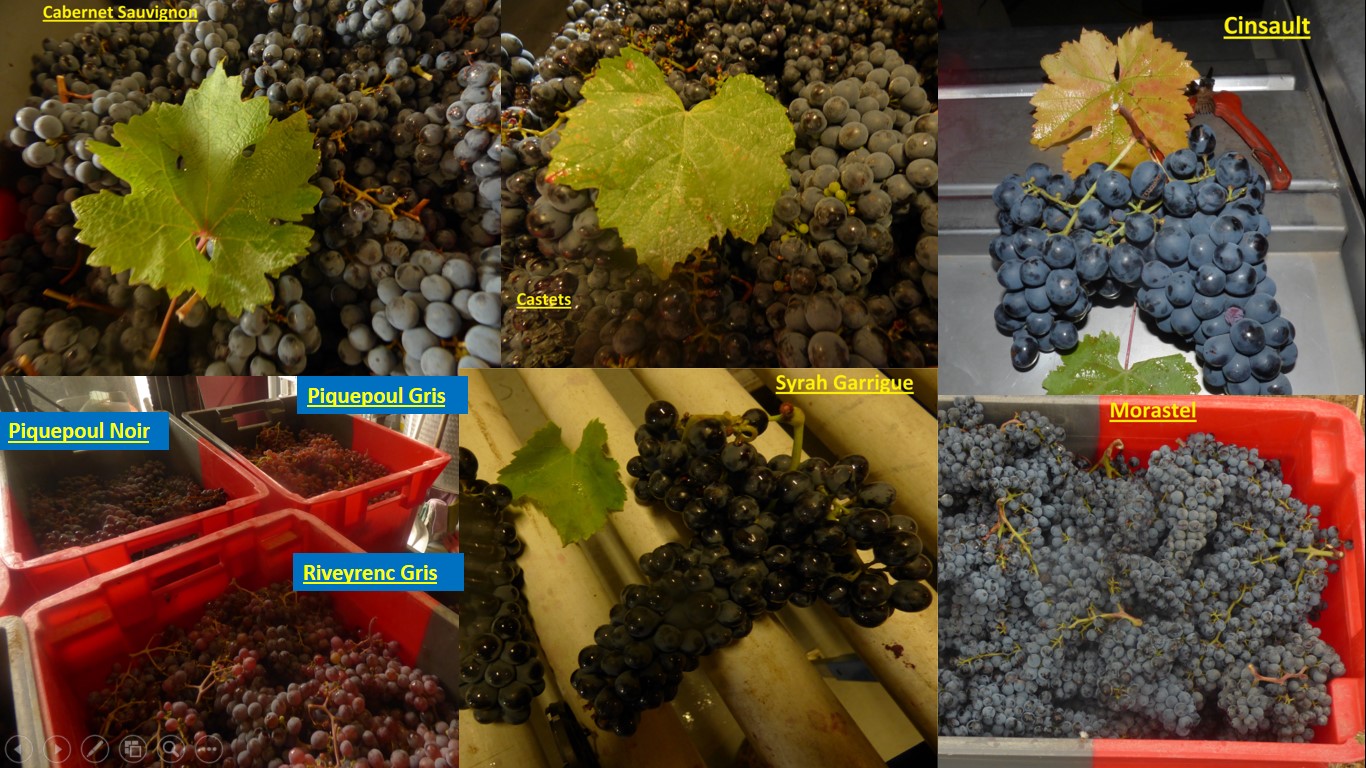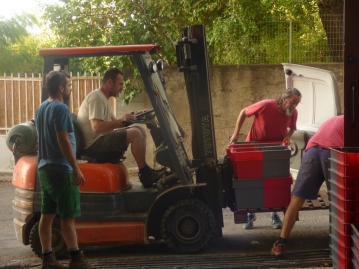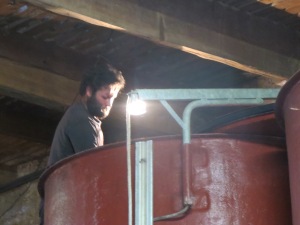
Version française
In my last post I described the leaves and some other features of the five main red grape varieties to be found in the Languedoc Roussillon region. This is all part of my attempt to learn how to identify different vines more easily. So what about other varieties which are to be found at Mas Coutelou?
Red grapes
Cabernet Sauvignon
Usually associated with Bordeaux and other regions of France there is Cabernet to be found in the Languedoc. Much was planted in the 1980s and 90s as Cabernet Sauvignon, Merlot and Chardonnay were the big sellers on world markets and vignerons here tried to make money from that market. It is easy to deride this move but vignerons have to make a living and if they can sell grapes then who is to blame them? Besides the domaine which first brought the Languedoc to the world stage, Mas de Daumas Gassac, uses these international varieties as part of their blends. I have to admit that it is not my favourite wine, certainly not the domaine’s red, but it has made an impact.
Anyway, to ampelography. I love Cabernet Sauvignon leaves, they are so easy to identify with their two eyes in the leaf which makes them look like a startled face.

Cabernet Sauvignon in Segrairals
A rich green colour the leaves have more lobes than most and the lower lobes overlap to cover the base of the pétiole sinus (the space where the stalk meets the leaf) giving the mouth like appearance you can see in the photo above. Generous teeth around the lobes are noticeable but it is the two spaces in the leaf which makes this easy for me to recognise. The grapes are small with hard skins and form small clusters too.
Recommended wines
Mas Coutelou – Buvette À Paulette
Others – Casa Pardet, Cabernet Sauvignon (Spain)

Cabernet Sauvignon grapes
Merlot
Poor old Merlot seems to be currently out of fashion. Seemingly everybody’s favourite in the 1990s I regularly hear people now say how it is their least favourite variety, and I confess it is one of my least popular grapes. It is capable of great things on the right bank of Bordeaux and elsewhere but it is little seen here in the Languedoc. Jeff has one parcel, Colombié, entirely planted with Merlot which is mainly used for restaurant blends and bag in box wine.

Merlot in La Colombé
The leaf in the photo shows that these are rich green in colour with 5 or 7 lobes. The sinus around the stalk is open and U shaped with a large white spot where the veins come together just above this sinus. In this photo the veins are quite green as they spread out. Medium sized teeth surround the leaves. Grapes are medium sized and so are the bunches so few clues there.
Mas Coutelou – 7, rue de la Pompe (small amount)
Others – Fons Sanatis, Coudereu
Aramon
This local grape was once widely planted in the Languedoc but was grubbed up in recent years as its reputation spread as wines with little flavour. This was unfair as it was often grown to give big yields and so flavours were diluted but there are many who still scorn it. Nevertheless, with low yields it can make good wines and there is a recent trend to replanting Aramon.

Aramon Noir in Font D’Oulette
The leaves are almost trefoil in character with big veins which stand out against the dark green colour. The teeth are quite large in the lower lobes and taper gently to the top. The pétiolar sinus is big and V shaped. It is the grapes which make Aramon identifiable. They are big in size and form large cylindrical clusters. This reinforces the reputation as a big cropper of light red wines, one of its synonyms is Pisse – Vin which needs no translation. However, this is unfair and Aramon is starting to make some interesting wines again.
Mas Coutelou – Flower Power
Others – Domaine Banjoulière, Aramon; Clos Fantine, Lanterne Rouge
White grapes
Less than 30% of wine produced in Languedoc Roussillon is white, I was actually surprised at how high that figure is. The last few years has seen Picpoul De Pinet become very trendy around the world, reaching prices over £30 in some UK restaurants for wine which costs around 5-6€ around here. Improvements in vinification and the use of temperature controls means that the quality of white wine being made here is improving and there are plenty of excellent examples.
Jeff produces a few cuvées of white wine but many of the white grapes are complanted, mixed together in the vineyard, to add complexity to the blend and an expression of terroir. In terms of identifying these varieties the challenge is, therefore, more complex, as they are mixed up I tend to be too! Therefore, I have only included the main white varieties of the domaine here, there are many, many others!
Muscat
There are actually many different varieties of Muscat just to make identification even more difficult, e.g. Muscat A Petits Grains, Muscat d’Alexandrie and there’s even a Muscat Noir just to completely baffle me. Muscat is usually used to make sweet wines such as Muscat De Rivesaltes, Muscat De Frontignan and Muscat De St. Jean De Minervois. Jeff uses it in dry blends, is considering using it for a pétillant wine this year and also uses it in his sensational solera system to make rich, sweet and dry old Muscats.

Muscat from La Garrigue

Muscat Noir, Font D’Oulette
Muscat has quite dark green leaves and can be in 5 lobes though both the photos above show just 3, almost like a maple leaf. There are some big teeth around the leaf edge. The leaf is also relatively long compared to the width at the base and the sinus around the stalk is V shaped. The other distinctive feature is the crinkly, dimpled appearance between the veins. The grapes are actually fairly medium in size (despite the Petits Grains name) but form small clusters. The grapes are distinctive in colour as they become golden and bronzed in the sunshine with freckles too!

Muscat grapes, admittedly more green than golden. These were picked early for dry wine.
Mas Coutelou – Vieux Muscat blends
Others – Treloar, One Block Muscat; Clos Gravillas, Muscat de St Jean de Minervois
Sauvignon Blanc
Not a variety much found in the Languedoc as it tends to prefer slow ripening and cooler climates. In Mas Coutelou it is used for blending with other white grapes to add a little zest and bite to the mix, picked early to keep that freshness as you can read here.

Sauvignon Blanc, La Garrigue
Quite round in shape with 5 lobes and teeth which are sizeable but more round than angular. The veins stand out as they are not coloured, reaching down to the stalk sinus which is often closed or barely open. One distinguishing feature which is observable in the photo is that the leaf tends to curl a little at the edge, note how one lobe is curling under the other on the right of the photo. Small bunches of oblong but small grapes.
Recommended – Turner Pageot, La Rupture
There are many other white varieties which I could add but these suffice for my needs. Carignan Blanc and Grenache Gris and Blanc are related to their black grape cousins and have similar appearances. Maccabeu, Picpoul etc are for another day but I think that is enough studying for the moment!

Viognier grapes in La Garrigue
There is a very pleasing trend in the Languedoc Roussillon towards replanting old varieties of vines. Terret, Ribeyrenc, Piquepoul Noir, for example were all planted at Mas Coutelou in March. And there remains the very rare Castets, brought in from Chateau Simone in Provence to be only the second vineyard to have this variety.

The famous Castets grapes of Peilhan
So ampelograhy is an ongoing lesson for me, if you want to find out more these websites are worth a visit.
http://www.vindefrance-cepages.org/en/vin-de-france (English and French)
http://lescepages.free.fr/ (French)










































































































